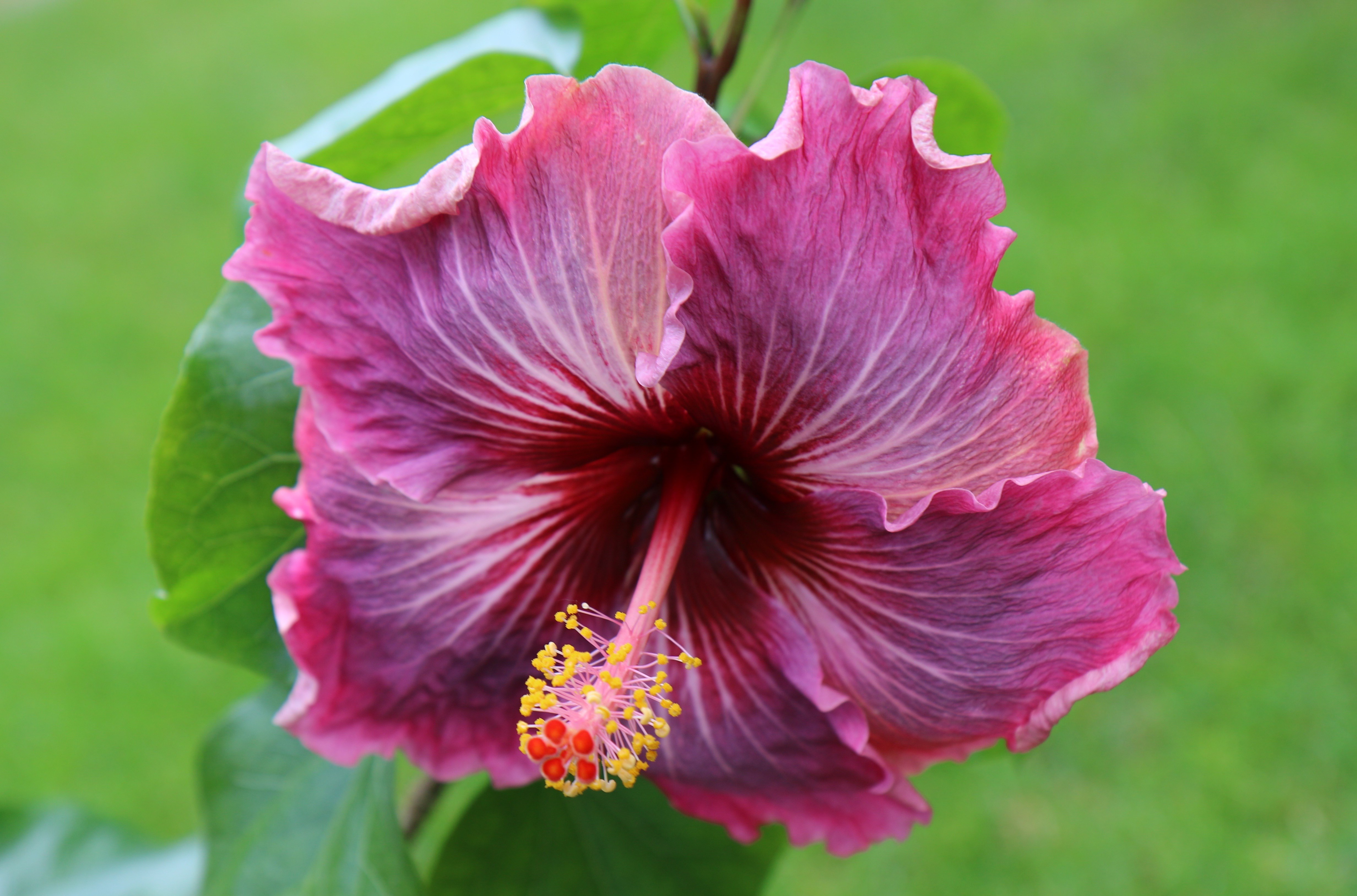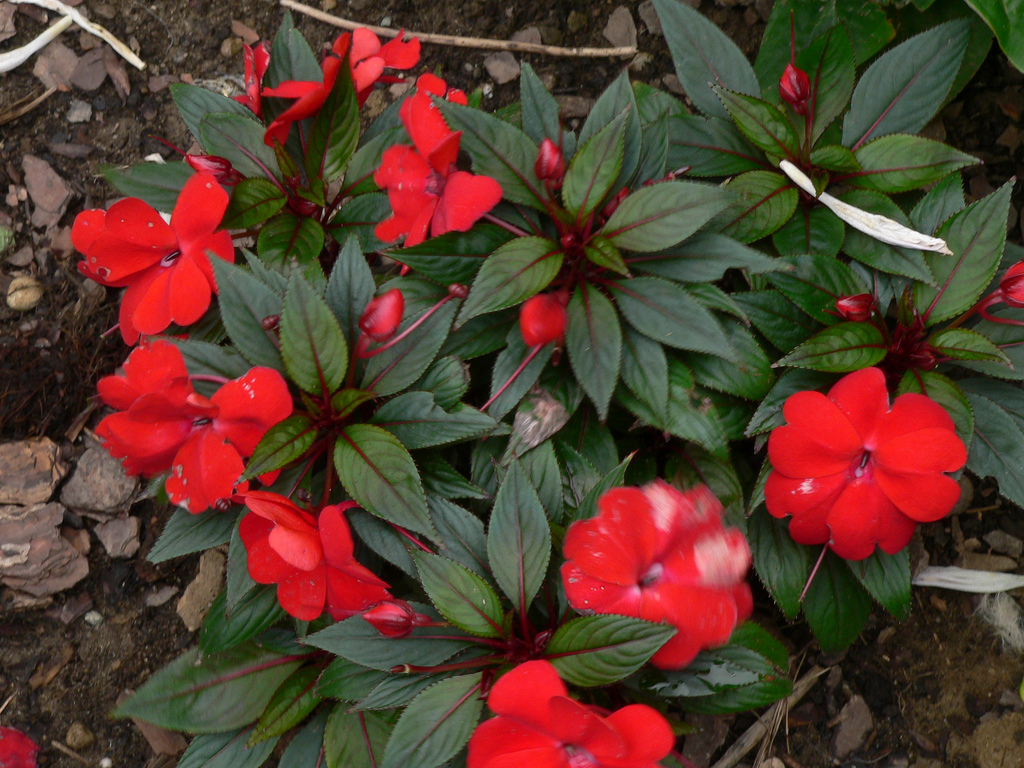Having a wonderful smell, garden hibiscus flowers not only delight the eye in the garden or on the windowsill in the apartment - they are also used to brew healthy and fragrant tea. This drink is known to many under the name "hibiscus tea". In addition, garden hibiscus is easy to care for and highly decorative.
Content
Garden hibiscus: photo and description
The flower of love or the flower of beautiful women is also the name of the tree-like hibiscus popular in Hawaii. Local girls adorn their hair with dazzlingly beautiful and bright flowers of this plant on holidays. The wide range of colors of the plant perfectly emphasizes the beauty of the hair.
Growing a plant in a garden is not a big hassle, and its splendor evokes a sense of serenity and tranquility, transferring to the unique world of pristine nature.
A beautifully flowering plant that can be grown both in an apartment and in a summer cottage. Garden hibiscus belongs to the Malvaceae group. In the natural environment, there are about 250 different varieties of this plant - they differ in shape and size, as well as the color of the flower and its size.
According to the shape of hibiscus, there are:
- Semi-shrubs;
- Shrubs;
- Herbaceous varieties;
- Decorative trees.
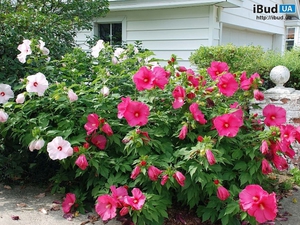 Flowers in many varieties of garden hibiscus are brightly colored, large, graceful... Some varieties differ significantly from each other. Different colors and shapes, the size of the flower and the plant itself.
Flowers in many varieties of garden hibiscus are brightly colored, large, graceful... Some varieties differ significantly from each other. Different colors and shapes, the size of the flower and the plant itself.
The frost-resistant garden and herbaceous varieties are very popular, since they are not very picky about care. The many varieties of garden tree hibiscus with funnel-shaped double and simple flowers are quite exotic and attractive. The color variety of plants is very large: you can see flowers from yellow, white to deep red, bright lilac, crimson, violet and purple... There are also two-tone varieties.
Its location in the garden will depend on the selected variety of hibiscus. Low-growing plants look great in mixed borders. Herbaceous hibiscus looks harmoniously with ground cover roses and ornamental deciduous plants. But the tree-like hibiscus can be beaten well by planting several plants with different flowers in a solitary standard planting.
- Hibiscus can tolerate frost down to -20C.
- Flowering is quite long - from late June to early October.
Garden hibiscus: care and reproduction
Growing this plant won't be a hassle. For normal flowering and growth, it is advisable to choose a sunny place where there is no wind. When planting hibiscus, you need to use humus-rich, loose and fertile soil. Watering must be frequent and regular.... The main thing is not to flood the plant, but it is important that the ground around the flower is constantly moist. If the plant is properly cared for, the life span of a hibiscus can be more than 15 years.
Young bushes need to be replanted several times.As a rule, the transplant is done in the spring. Already 2 months after rooting, the plant can be transplanted into a larger pot. For planting, a mixture of earth from sheet, sod soil, sand and humus is used in a ratio of 3: 4: 1: 1. Every year, after transplanting, soil must be added to the pot.
Proper care after planting young bushes is important, especially in winter. The plant should overwinter in a shelter, as it may not endure frost... If the planting of bushes is scheduled for autumn, then before the arrival of the winter season, you need to mulch the land near the flower.
Fertilizers for hibiscus must contain an increased amount of phosphorus. Before winter, it is advisable to feed the bush with potash fertilizer. This will make it easier for the plant to winter.
Syrian hibiscus: photo and description
The Syrian hibiscus is characterized by unusually lush flowers.
Lavender chiffon
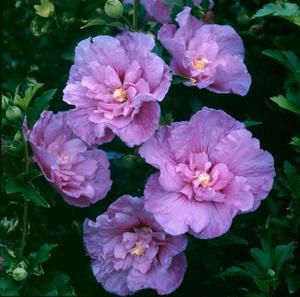 A relatively new English variety with semi-double and double flowers. The color is blue-pink with a deep red center.
A relatively new English variety with semi-double and double flowers. The color is blue-pink with a deep red center.
A small tree or deciduous shrub of medium size up to 3 meters and a crown circumference of 1.7 m. It grows well in a sunny area, but also tolerates light shading.
It has various uses: it is possible a tapeworm against the background of a lawn, you can plant a plant in the background in flower beds or to decorate fences, it all depends on where the sun's rays fall more.
Duke de Brabant
A small tree or deciduous shrub of average height about 2-3 m and a crown circumference of 1.7 meters. The inflorescences are large and rather attractive, violet-red with burgundy-red or dark red blotches in the center, double, 10-12 cm in size. Grows well in a sunny area, but can tolerate light shading.
Garden hibiscus tree: photo and description
The tree-like garden hibiscus is a deciduous shrub that blooms for 6 months, but one flower only lasts a day. New inflorescences immediately replace wilted petals. Hibiscus blooms at the end of June, and renews its flowers until October.
In temperate climates, plant height no more than 2.5 m, although in the natural environment tree-like varieties reach a size of up to 6 m. Large ovoid or oval-shaped leaves have a rich green color. The inflorescences are single, rather large, reaching up to 28-31 cm in circumference.
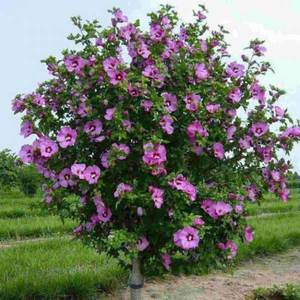 Disembarkation takes place in the spring. Take care that the tree you are growing in the garden is protected from drafts. During the care and cultivation of hibiscus, do not forget that the plant is thermophilic and demanding on lighting. If you plant it in a shaded area, then it will both grow slowly and bloom weakly.
Disembarkation takes place in the spring. Take care that the tree you are growing in the garden is protected from drafts. During the care and cultivation of hibiscus, do not forget that the plant is thermophilic and demanding on lighting. If you plant it in a shaded area, then it will both grow slowly and bloom weakly.
If your backyard is located in an area with a cool climate, then plant non-double species - they are the most hardy. For a plant to bloom profusely, it needs a small pruning every two years.... Supplement the hibiscus with lavender bushes to protect the hibiscus from aphids.
Hibiscus requires fertile land with normal water permeability. Strong watering is not required for this flower - it is necessary to moisten the ground only after it dries. Abundant flowering will be ensured if you do not forget about the constant phosphorus baits. Potassium supplements are also needed - with the help of them, wintering the flower will be easier.
Suitable for growing in pots. The plant must choose the ideal, in the literal sense of the word, place - otherwise, when turning or transferring a flowering bush, there is a great risk of breaking weak peduncles. Choose a warm and sunny area, protected from drafts. In a pot, the bush must be trimmed periodically - this can help maintain its decorative shape.
Herbaceous hibiscus: photo and description
A distinctive feature is a long flowering time, and its peduncles are 2-3 times larger in size, in contrast to tree varieties. Another advantage of the herbaceous variety is its high frost resistance.
The bush has many erect shoots that sprout every year. The flowers of this plant are colored cherry-crimson... It is advisable to plant the flower in the central part of the garden or in the background, because of its rather large size - about 3 meters.
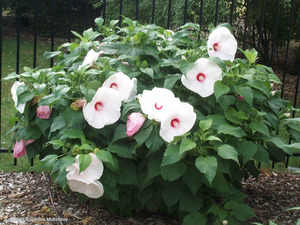 When caring for this hibiscus, it must be borne in mind that the roots of the bush look like potatoes, their damage leads to the death of the plant. Therefore, in winter, after the dying off of the bush, it is advisable to place a plate at the place of growth of the hibiscus, which indicates its location and protects the bush from digging.
When caring for this hibiscus, it must be borne in mind that the roots of the bush look like potatoes, their damage leads to the death of the plant. Therefore, in winter, after the dying off of the bush, it is advisable to place a plate at the place of growth of the hibiscus, which indicates its location and protects the bush from digging.
The bright and large flowers of herbaceous hibiscus are in perfect harmony with different plants, so be sure to plant it in your garden.
Typically, herbaceous species are grown in large group plantings or in the formation of curbs. These plants can be used to decorate the coastal area of the home pond. But cultivation must be carried out in sunny places, protected from drafts.
The plant has no special requirements for soil... It develops better on loams, and does not tolerate calcareous soil. An important role in the care of hibiscus is played by drainage at the planting site and periodic loosening, since waterlogging and waterlogging of the soil can cause the death of the bush.
In the spring, you need to build greenhouses from film, since the flower loves warmth and moisture. Under these conditions, the plant will develop much faster. With the arrival of summer, greenhouses are removed. The herbaceous cultivar loves constant watering, especially in the early stages of cultivation. At the end of flowering, watering should be slightly reduced.
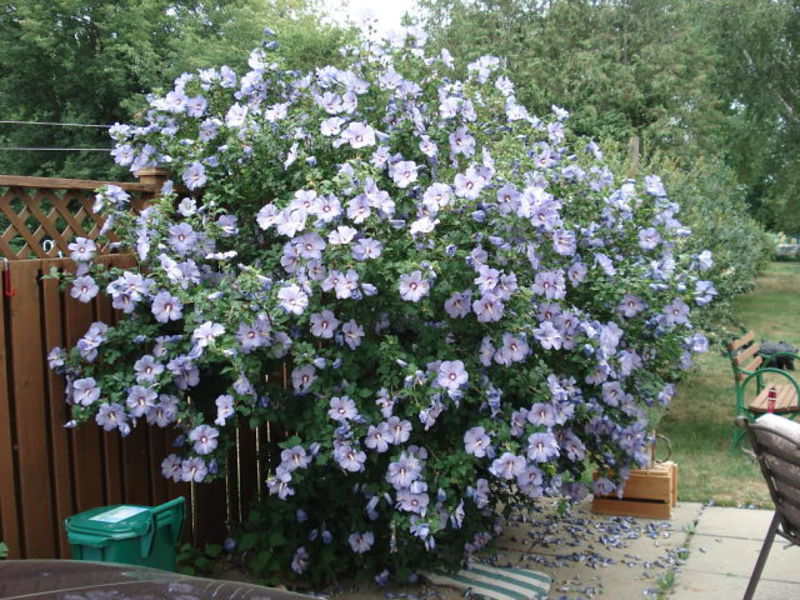
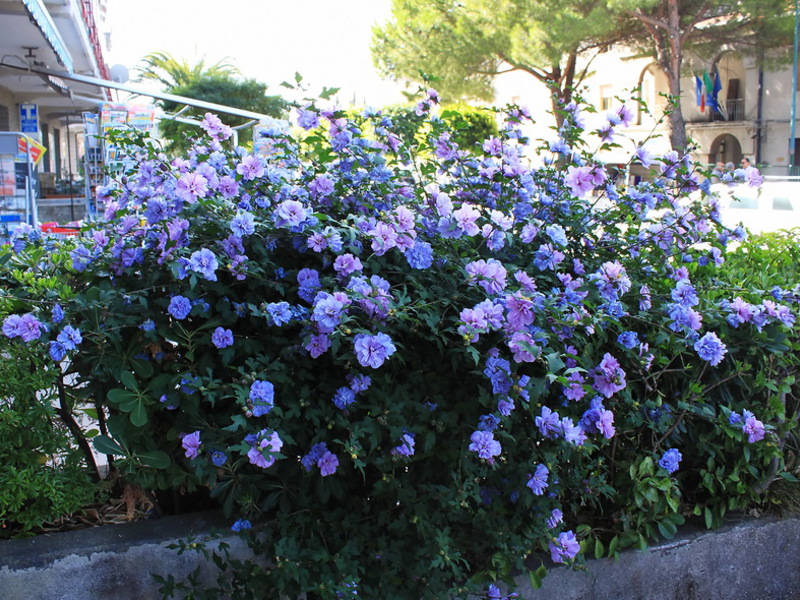
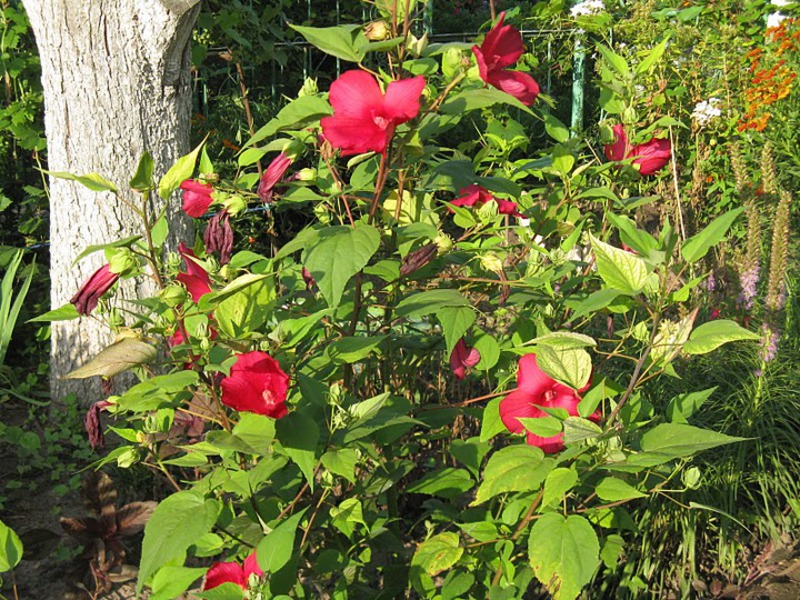
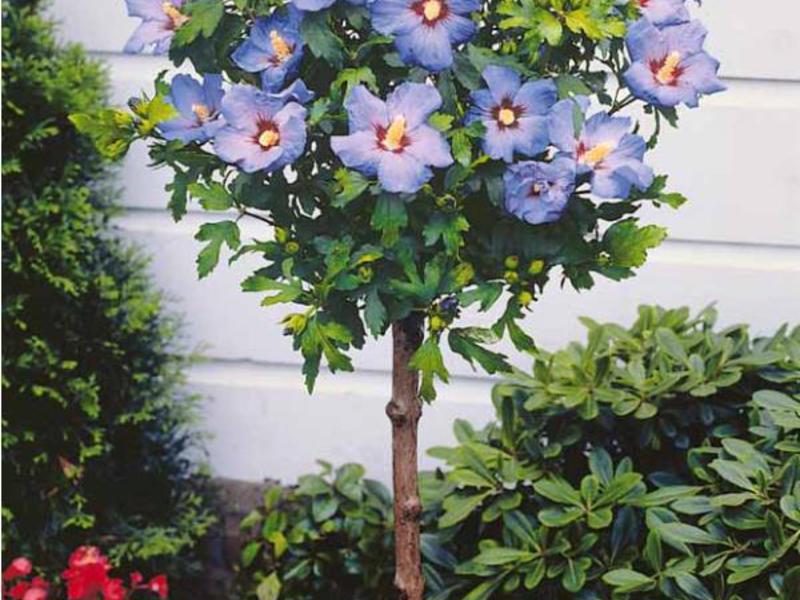
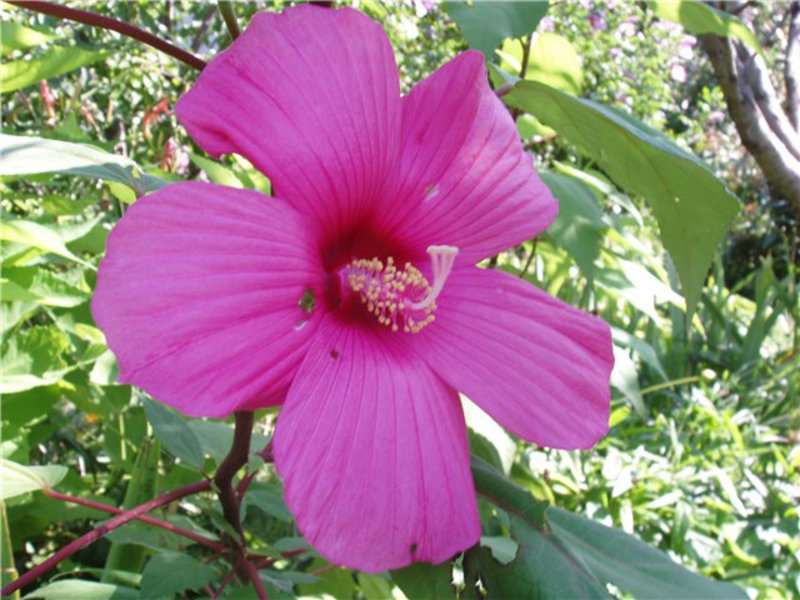
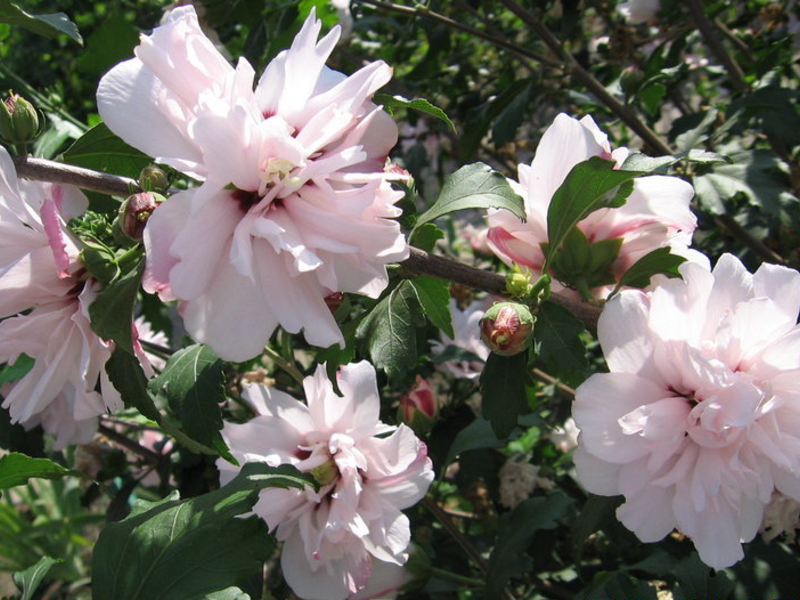
Pruning garden hibiscus
Periodic pruning of the hibiscus is necessary; pruning the shoots is good for the plant. The bush forms flower buds on young shoots. In addition, pruning is required for the plant to give a decorative shape.
In the spring, the growth of hibiscus of the last year is shortened by 1/3... This significantly increases the number of new kidneys. As the plant grows thicker over time, it needs light, periodic thinning.
How to prune hibiscus?
- After planting a young plant, remove all damaged and weak shoots. For uniform growth of a lush plant, and in the future, it requires a cardinal pruning. If you want to form a stem tree, then you need to be patient, since it takes more than one year to grow a stem.
- Trim branched shoots to the level of multiple buds. The main trunk is not trimmed. In the next season, from February, again cut the lateral branched shoots to one bud, and the main trunk - to 6-7 buds. When the bush reaches the size you need, form a crown from the strongest shoots, making it several buds shorter, cutting off the top of the trunk and removing all the lateral lower shoots.
- When you have achieved the desired crown shape, then only cut dry and weak shoots in the future. Cut thin branches to several buds. If over time the plant becomes one-sided, then remove unwanted branches on it to the base or cut them to lateral young shoots.
Reproduction of hibiscus
During the care of hibiscus, reproduction is carried out by cuttings, dividing the bush, and also by seeds. If you decide to grow a plant from seeds, then do not forget that this process can be done only after stratification.
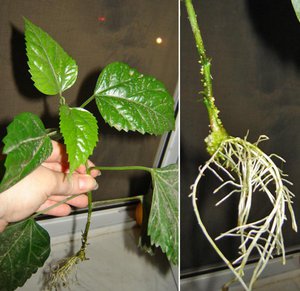 The material for planting is covered with a small layer of earth, a little moistening is made, for example, with a sprayer, and set in the refrigerator for a month. After the propagation of hibiscus by seeds, sowing is done in the prepared substratemixed from sand and peat. The container must be closed with polyethylene or glass and left at a temperature of 25-27 g. Carry out periodic ventilation and spraying of the container. Then, when the seeds germinate, you need to wait for the formation of several leaves. These seedlings dive into different pots. The flowering of a flower bed of hibiscus grown from seeds occurs only in the third year.
The material for planting is covered with a small layer of earth, a little moistening is made, for example, with a sprayer, and set in the refrigerator for a month. After the propagation of hibiscus by seeds, sowing is done in the prepared substratemixed from sand and peat. The container must be closed with polyethylene or glass and left at a temperature of 25-27 g. Carry out periodic ventilation and spraying of the container. Then, when the seeds germinate, you need to wait for the formation of several leaves. These seedlings dive into different pots. The flowering of a flower bed of hibiscus grown from seeds occurs only in the third year.
If the propagation of hibiscus is done by cuttings, then the best time for this is spring.From new shoots, it is necessary to cut off the upper cuttings, which have several internodes. Cutting is done 5 cm below the node... After that, the top of the stem is cut over the knot and a cut is made on the resulting cuttings. From the bottom of the segment, you must remove the stem segment and leaves. The few remaining leaves are cut in half.
To speed up the development processes, the cutting is treated with growth stimulants, and then buried in the ground to the nodes. The planting is covered with a film and kept at a temperature of 18–20 grams. After a month, the bush will take root and can be transplanted to a permanent place. This plant will begin to bloom one year after planting.
A prolific and hardy hibiscus does not require much attention, but it always adorns any garden plot with beautiful flowers. All you have to do is plant additional plants to compensate for the sterile time of one plant with another. But in any case, hibiscus is a versatile plant. Its beautiful flowers and ease of care have made it one of the most popular shrubs to be grown in a garden or apartment.
